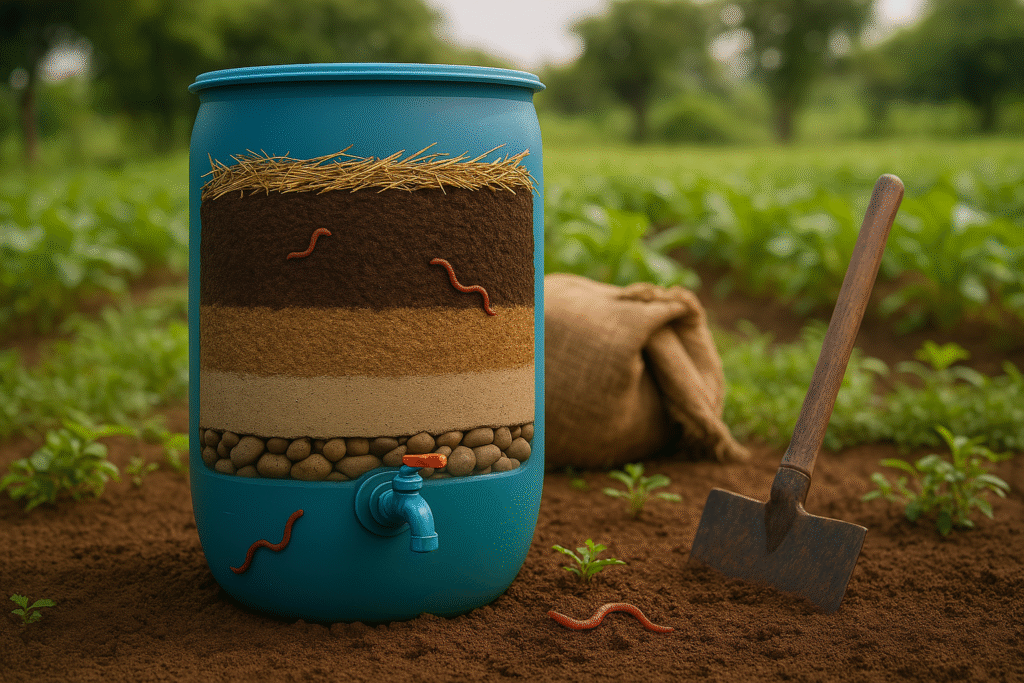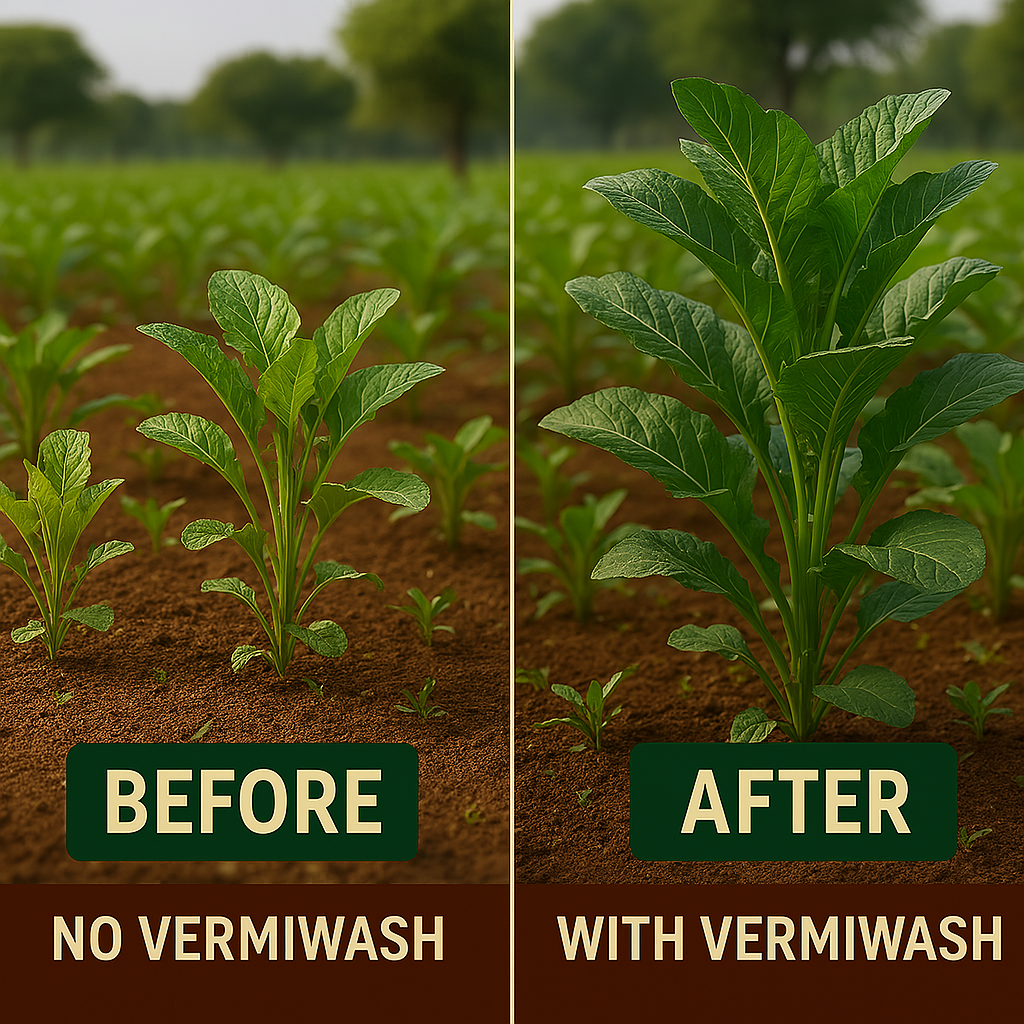Vermiwash Benefits and Uses | How to Use Vermiwash in Organic Farming | BharatKhaad
Vermiwash is a nutrient-rich liquid extracted from vermicompost beds through a natural leaching process.It is a natural growth stimulant and organic fertiliser that increases soil fertility, strengthens immunity, and promotes plant health. This blog explains what vermiwash is, its benefits, and step-by-step guidance on how to use it in organic farming.

What is Vermiwash?
Vermiwash is a liquid extract collected by watering vermicompost beds or through special vermiwash units that capture the nutrient-rich leachate from decomposed organic matter processed by earthworms.Enzymes, plant growth hormones, vital nutrients, and helpful microorganisms are all present in this liquid.
Vermiwash Benefits and Uses in Organic Farming
- 🌿 Rich in nutrients like nitrogen, phosphorus, potassium, and micronutrients
- 🦠 includes beneficial microorganisms that enhance plant immunity and soil health.
- 🌱 Promotes faster seed germination and root development
- 🌾 Enhances crop yield, flowering, and fruit quality
- 🛡️ Natural pest repellent and disease suppressor
- ♻️ Eco-friendly and sustainable liquid fertilizer alternative

How to Prepare Vermiwash
- Set up a vermicompost bed with adequate moisture and earthworms.
- Place a perforated container or mesh at the base to collect liquid.
- Water the bed regularly to allow nutrient-rich leachate to percolate.
- Collect the filtered liquid (vermiwash) from the collection tray.
- Store vermiwash in a cool, shaded place and use fresh for best results.

How to Use Vermiwash on Your Farm/Vermiwash Benefits and Uses
1. Foliar Spray
Dilute vermiwash with water in a 1:10 ratio and spray on plant leaves weekly to enhance growth and pest resistance.
2. Soil Drench
Apply vermiwash diluted 1:10 directly to the soil near plant roots to improve nutrient uptake and microbial activity.
3. Seed Treatment
Soak seeds in diluted vermiwash for 2-3 hours before sowing to promote faster germination and healthy seedlings.
Precautions and Best Practices
- ✔️ Use fresh vermiwash for maximum microbial activity
- ✔️ Avoid direct application without dilution to prevent plant burn
- ✔️ Store in airtight containers away from sunlight
- ✔️ Combine with solid organic fertilizers for balanced nutrition
🌿 How to Use Vermiwash in Organic Farming
Vermiwash, a liquid organic fertiliser made from the leachate of vermicompost systems, is incredibly effective. Rich in plant growth hormones, enzymes, and beneficial microorganisms, it plays a vital role in boosting plant health and crop yield naturally. Here’s how to use it effectively in various ways in your organic farming practices:
1. 🌱 Foliar Spray (Leaf Spray)
What It Is:
A foliar spray means applying diluted vermiwash directly on the leaves of plants.
How to Use:
- Dilute vermiwash in water at a 1:10 ratio (1 part vermiwash + 10 parts water).
- Fill the solution into a hand sprayer or knapsack sprayer.
- Spray it on plant leaves in the early morning or late afternoon to avoid sunburn.
- Apply once a week for best results.
Benefits:
✅ Enhances photosynthesis
✅ Improves pest resistance naturally
✅ Increases leaf size and strength
✅ Supplies nutrients directly through stomata
2. 🌾 Soil Drench (Root Application)
What It Is:
Applying diluted vermiwash directly into the soil near plant roots to enrich the soil environment.
How to Use:
- Use the same 1:10 dilution ratio.
- Pour the diluted vermiwash at the base of the plant, especially near the root zone.
- Apply every 10–15 days or as needed during the growing season.
Benefits:
✅ Improves soil microbial life
✅ Boosts root development
✅ Enhances nutrient absorption
✅ Increases overall plant strength

3. 🌰 Seed Treatment (Pre-Sowing)
What It Is:
Soaking seeds in vermiwash before planting to improve germination and seedling health.
How to Use:
- Dilute vermiwash in water at a 1:10 ratio.
- Soak seeds for 2–3 hours before sowing.
- Remove, dry slightly, and plant as usual.
Benefits(Vermiwash Benefits and Uses):
✅ Speeds up germination
✅ Strengthens initial root growth
✅ Protects seeds from fungal infections
✅ Results in healthier seedlings
4. 🌿 Plant Cutting or Sapling Dip
What It Is:
Soaking plant cuttings or saplings in vermiwash solution before planting.
How to Use:
- Dip the root zone of saplings or the base of cuttings in 1:10 diluted vermiwash for 15–30 minutes.
- Transplant immediately afterward.
Benefits:
✅ Reduces transplant shock
✅ Promotes quick root establishment
✅ Encourages faster growth after planting
🔒 Best Practices & Tips
✔️ Always use fresh vermiwash for maximum microbial activity
✔️ Never use undiluted vermiwash directly on plants — it may cause burn
✔️ Vermiwash should be kept in an airtight, dark, and cool container.
✔️ Combine with other organic fertilizers like vermicompost or neem khali for best results
✔️ Use a fine nozzle spray to ensure even coverage when spraying on leaves
💡 Final Thoughts
Using vermiwash in organic farming is a simple yet powerful way to boost crop productivity naturally. Whether you apply it as a foliar spray, soil treatment, or seed soak, it promotes healthy, sustainable growth without the harmful effects of chemical fertilizers.
Integrate vermiwash into your farming routine, and you’ll witness healthier soil, stronger plants, and better yields – the organic way!
🌿 Vermiwash Preparation and Application Methods
Vermiwash is a liquid organic fertilizer obtained by allowing water to pass through a column of worm culture (vermicompost and earthworms). It is rich in plant growth hormones, micronutrients, beneficial microbes, and enzymes. Vermiwash acts as a natural bio-pesticide and tonic for plants.
🧪 Vermiwash Preparation Methods
There are mainly two methods to prepare vermiwash:
1. Traditional Vermiwash Setup (Barrel or Drum Method)
Materials Required:
- A plastic or cemented barrel with a tap at the bottom (100–200 litres capacity)
- Vermicompost (cow dung + biodegradable waste)
- Earthworms (Eisenia fetida or Eudrilus eugeniae)
- Gunny bag or mesh net
- Straw or dry leaves
- Water
Steps to Prepare:
- Setup the Barrel: Install a tap to collect vermiwash at the barrel’s bottom.
- Layering:
- Place small stones or pebbles at the bottom (3–4 inches) for drainage.
- Apply a layer of coarse sand that is 4–6 inches thick.
- Add a layer of vermicompost mixed with earthworms (around 10–15 kg).
- Cover it with dry straw or gunny bag.
- Water Spraying:
- Start slowly dripping or spraying water from the top (about 1–2 litres per hour).
- Collect the drained liquid from the tap after 7–10 days.
- Vermiwash is this liquid; keep it in an airtight container.
✅ Tip: Use chlorine-free water (e.g., rainwater or well-settled tap water) for better results.
2. Pit or Tank-Based Method (Large Scale Farming)
For large-scale production, you can use a cemented pit or tank.
Process:
- Prepare a tank with a sloped base and an outlet.
- Fill with layers of gravel, sand, and vermicompost.
- Introduce earthworms.
- Water regularly over 7–10 days.
- Collect the vermiwash from the outlet.
🌱 Vermiwash Application Methods in Organic Farming
Vermiwash is very versatile and can be used in various ways for better crop yield and plant health.
1. Foliar Spray (Most Common)
- Dilution: Mix 1 part vermiwash with 10 parts water.
- Spray on leaves during morning or evening hours.
- Repeat every 7–10 days.
- Improves photosynthesis, leaf health, and pest resistance.
2. Soil Drenching
- Dilute vermiwash in the same 1:10 ratio.
- Pour directly at the root zone of plants.
- Enhances root development and microbial activity in the soil.
3. Seed Treatment
- Soak seeds in diluted vermiwash (1:10) for 8–12 hours before sowing.
- Helps in faster germination and protection against soil-borne diseases.
4. Compost Activator
- Sprinkle vermiwash on compost heaps to accelerate decomposition.
- Boosts microbial growth in the compost.
5. Hydroponics & Nursery Use
- Can be added to hydroponic nutrient solutions (with care).
- Ideal for use in nursery trays to boost seedling growth.
⚠️ Precautions While Using Vermiwash
- Always dilute before use, as raw vermiwash may burn plant tissue.
- Do not overuse; excessive application can cause salt buildup in soil.
- Store in a cool, dark place and use within 30–45 days.
- Shake well before each use.
🌾 Benefits of Using Vermiwash
- Natural plant growth enhancer
- Environment-friendly alternative to chemicals
- Promotes disease resistance
- Improves soil fertility and microbial life
✅ Best Way to Apply Vermiwash on Crops
Vermiwash is an organic liquid fertiliser that is rich in nutrients and made from vermicompost. It acts as a bio-stimulant and protects plants against pests and diseases. For maximum benefit, vermiwash should be applied properly and regularly. The best technique to apply it to crops is as follows:
🌿 1. Foliar Spray (Most Effective Method)
Why this is best: Foliar spray delivers nutrients directly to the leaves, where plants absorb them quickly. It serves as a natural insect repellant as well.
How to apply:
- Dilution Ratio: Mix 1 part vermiwash with 10 parts water (1:10 ratio).
- Spray Time: Early morning or late evening (to avoid leaf burn).
- Equipment: Use a hand sprayer, knapsack sprayer, or power sprayer for large areas.
- Frequency: Spray every 7 to 15 days, depending on crop type and growth stage.
🌱 Result: Greener foliage, improved flowering, better fruit set, and natural resistance to pests and fungal infections.
🌱 2. Soil Drenching (Root Zone Application)
Why this helps: This method improves soil microbial life, boosts root health, and supports nutrient absorption.
How to apply:
- Dilution: Same as foliar spray (1:10 with water).
- Where to apply: Pour directly near the root zone of the plant.
- Frequency: Once every 2–3 weeks.
🔄 Ideal during the early stages of crop growth or after transplanting to reduce stress and boost root establishment.
🌾 3. Seed Treatment
Purpose: Boost germination, protect seeds from soil-borne diseases.
How to apply:
- Soak seeds in diluted vermiwash (1:10) for 8 to 12 hours.
- Allow seeds to dry in the shade before sowing.
🪴 4. Nursery and Sapling Treatment
How to apply:
- Spray diluted vermiwash on seedlings weekly.
- Helps strengthen young plants before transplanting.
📌 General Tips for Best Results
- Always dilute vermiwash before using.
- Avoid spraying during peak sunlight hours.
- Shake the solution well before use to activate microbes.
- Combine with neem extract or cow urine for pest control (optional).
- Use regularly throughout the crop cycle for consistent results.
🌾 Example Application Schedule (For Vegetables):
| Stage | Application Method | Frequency |
|---|---|---|
| Seed Treatment | Soaking | Once (before sowing) |
| Vegetative Growth | Foliar Spray | Every 7–10 days |
| Flowering/Fruiting | Foliar + Soil Drench | Every 15 days |
🌿 Natural Liquid Fertilizer Benefits for Plants
Natural liquid fertilizers are organic nutrient-rich liquids made from compost, vermicompost, plant extracts, or animal-based materials like cow dung and urine. Unlike chemical fertilizers, they are eco-friendly, safe, and promote sustainable plant growth.
Let’s explore the major benefits of using natural liquid fertilizers in farming and gardening:
✅ 1. Fast Nutrient Absorption
Plants may readily absorb natural liquid fertilisers through their roots and leaves. When applied as a foliar spray, nutrients enter directly into the plant’s system, leading to quick visible results like greener leaves, stronger stems, and better flowering.
🟢 Example: Vermiwash or Jeevamrut foliar sprays improve leaf color within a few days.
✅ 2. Boosts Soil Health & Microbial Life
These fertilizers promote the growth of beneficial microbes in the soil, which help:
- Improve nutrient cycling
- Break down organic matter
- Protect roots from harmful pathogens
🌱 Long-term use results in loose, fertile, and biologically active soil.
✅ 3. Increases Plant Immunity & Resistance
Many natural liquid fertilizers contain enzymes, hormones, and anti-fungal properties that strengthen plants from within. They:
- Reduce disease incidence
- Repel common pests (aphids, whiteflies, etc.)
- Prevent fungal attacks
🔰 Example: Neem extract or vermiwash works as a natural pest deterrent.
✅ 4. Enhances Flowering, Fruiting & Yield
Natural fertilizers like compost tea, cow urine solution, or seaweed extract are rich in growth-promoting hormones (like auxins and cytokinins). They help in:
- More buds and flowers
- Higher fruit set
- Uniform fruit size and taste
🍅 Results in better quality produce with high nutritional value.
✅ 5. Completely Safe and Eco-Friendly
Unlike synthetic fertilizers, natural liquid fertilizers:
- Do not harm soil or water bodies
- Are safe for humans, pets, and beneficial insects
- Leave no toxic residues on crops
♻️ Ideal for organic farming, terrace gardening, and sustainable agriculture.
✅ 6. Affordable and Easy to Make at Home
Natural liquid fertilizers like Vermiwash, Jeevamrut, Panchgavya, Banana Peel Liquid, etc. can be easily prepared using kitchen or farm waste.
💰 Low cost, high impact solution for small and large farmers alike.
✅ 7. Suitable for All Plants and Crops
Due to their versatility, these fertilisers can be used for:
- Vegetables
- Fruits
- Flowers
- Indoor plants
- Field crops and trees
🪴 Whether in pots or farms, natural liquid fertilizers support healthy plant growth everywhere.
Why Choose BharatKhaad Vermiwash?
Bharatkhaad.com offers high-quality vermiwash produced using healthy earthworms and pure organic inputs. Our vermiwash supports sustainable farming practices and improves overall crop health.
Customer Testimonials
🌟 “Bharatkhaad’s vermiwash helped my plants grow stronger and resist pests naturally.” – Rohit, Rajasthan
🌟 “Best natural liquid fertilizer for my organic farm, highly recommended.” – Anjali, Kerala
Conclusion
Vermiwash is a potent organic liquid fertiliser that improves soil quality, encourages robust plant development, and naturally safeguards crops. Use vermiwash as part of your organic farming practice to increase yields in a sustainable manner.
Order premium vermiwash from Bharatkhaad.com and boost your organic farming success today! 🌿🌱
❓ Frequently Asked Questions (FAQs) About Vermiwash
1. What is vermiwash used for?
Vermiwash is used as a liquid organic fertilizer and pest repellent. It enhances plant growth, improves soil fertility, and increases crop yield naturally.
2. Can vermiwash be used directly?
No, always dilute vermiwash with water in a 1:10 ratio before application to avoid plant damage.
3. How often should I apply vermiwash?
For best results, use as a foliar spray or soil drench every 7–15 days, depending on the crop type.
4. How long can vermiwash be stored?
You can store vermiwash for up to 30–45 days in a cool, dark, airtight container.
5. Is vermiwash suitable for all types of crops?
Yes, it is suitable for vegetables, flowers, fruits, grains, and even indoor potted plants.
Also checkout-:
Bharat Bio Gold – 100% Organic Fertilizer for 3X Crop Yield
Top 3 Benefits of Coco Peat | Organic & Eco-Friendly Growing Medium
Top 10 Indoor Plants – Stylish, Easy, Air-Purifying
Top 5 Mitti Pots for Healthy Cooking | Eco-Friendly Clay Cookware
Top 7 Ceramic Pots for Home Décor | Elegant & Durable Planters
Top 5 Colorful Cemented Pots for Garden & Home
Top 5 Green Grow Bags for Gardening – Reusable & Eco-Friendly
Top 10 Decorative Plant Pots – Stylish & Durable Options
Mustard Cake Fertilizer – 100% Organic Plant Booster for Bigger Blooms
Vermiwash – 100% Organic Liquid Fertilizer for 2X Plant Growth
Cold-Pressed Neem Oil – 100% Organic Insect Control for 30+ Pests
BharatKhaad Organic Bone Powder – 2X Root & Flower Growth Naturally
Neem Khali – 100% Organic Pest & Soil Solution for Healthier Crops
Buy Organic Vermicompost – 100% Natural Soil Booster for 3X Growth
